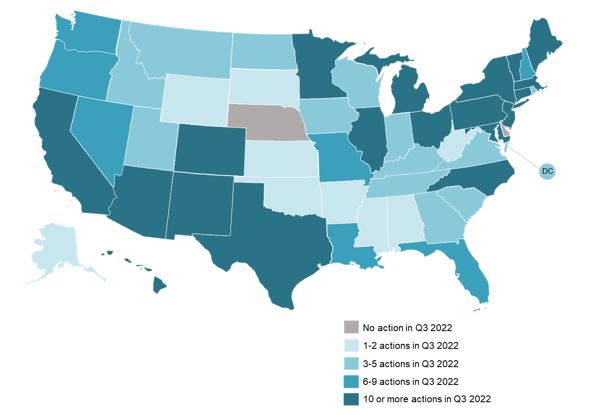The 50 States of Grid Modernization Q3 2022: Performance-Based Ratemaking, Storage Rate Design, & Resource Procurement Methods in Focus During Q3 2022
Raleigh, NC – (October 26, 2022) The N.C. Clean Energy Technology Center (NCCETC) released its Q3 2022 edition of The 50 States of Grid Modernization. The quarterly series provides insights on state regulatory and legislative discussions and actions on grid modernization, utility business model and rate reforms, energy storage, microgrids, and demand response.
The report finds that 48 states, as well as the District of Columbia, took actions related to grid modernization during Q3 2022 (see figure below), with the greatest number of actions relating to energy storage deployment (66), utility business model reforms (45), smart grid deployment (39), distribution system planning (27), advanced metering infrastructure deployment (26), and time-varying rates (22).
A total of 441 grid modernization actions were taken during Q3 2022. California, New York, Massachusetts, Michigan, Illinois, Connecticut, and Hawaii took the greatest number of actions during the quarter, followed by New Jersey, Minnesota, Colorado, and New Mexico.
Q3 2022 Legislative and Regulatory Action on Grid Modernization

The report discusses three trends in grid modernization actions taken in Q3 2022: (1) states moving toward performance-based regulation; (2) states and utilities examining rate designs for energy storage facilities; and (3) states moving toward competitive procurement of resources.
“This quarter, states and utilities continued to respond to the issue of energy demand amidst the changing climate. Several utilities found progress in the area of energy storage — stipulated in numerous approved IRPs –, with many favorably viewing renewable-paired storage as a worthy demand-flexible mechanism,” said Justin Lindemann, Policy Analyst at NCCETC. “Other utilities are planning out energy storage projects with a resilience component, in order to help communities avert the risk of weather-induced power outages. We notably saw movement in the space of energy resiliency amongst states like Connecticut, Minnesota, and Vermont.”
The report notes the top five policy developments of Q3 2022 were:
- Massachusetts lawmakers establishing electric sector modernization planning requirements;
- First Energy filing its Grid Mod II investment plan in Ohio;
- The Illinois Commerce Commission approving utility performance metrics;
- New Jersey regulators issuing a storage incentive program straw proposal; and
- California regulators opening a rulemaking to advance demand flexibility through rates.
“A growing number of states are pursuing reforms to traditional utility business models and resource procurement methods,” observed Autumn Proudlove, Associate Director of Policy and Markets at NCCETC. “We’re seeing particular movement toward the use of performance incentive mechanisms, as well as regulators in a number of states requiring the use of all-source competitive procurements by vertically-integrated utilities.”
View the 50 States of Grid Modernization Q3 2022 Quarterly Report Executive Summary
View and Purchase the 50 States of Grid Modernization 2022 Q3 Update FULL Report
View other 50 States Reports – Solar, Grid Modernization and Electric Vehicles
ABOUT THE N.C. CLEAN ENERGY TECHNOLOGY CENTER
The N.C. Clean Energy Technology Center, as part of the College of Engineering at North Carolina State University, advances a sustainable energy economy by educating, demonstrating and providing support for clean energy technologies, practices and policies. It serves as a resource for innovative, sustainable energy technologies through technology demonstration, technical assistance, outreach and training. For more information about the Center, visit: http://www.nccleantech.